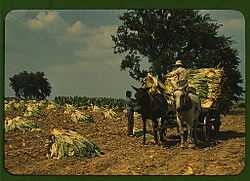Burley (tobacco)


Burley tobacco is a light air-cured tobacco used primarily for cigarette production. In the United States it is produced in an eight-state belt with approximately 70% produced in Kentucky. Tennessee produces approximately 20%, with smaller amounts produced in Indiana, North Carolina, Missouri, Ohio, Virginia, Maryland and West Virginia. Burley tobacco is produced in many other countries, with major production in Brazil, Malawi and Argentina.
History

In the U.S., burley tobacco plants are started from pelletized seeds placed in polystyrene trays floated on a bed of fertilized water in March or April. Transplanting begins in May and progresses through June with a small percentage set in July. Producers must contend with major diseases such as black shank and blue mold and insects like aphids, hornworms and budworms. Plants are topped by removing the developing flower head at approximately 60 days from transplanting, and treated to prevent the growth of side shoots called suckers. Topping allows energy that would have produced a bloom to promote leaf expansion. At approximately four weeks after topping, the tobacco is stalk cut, using a knife that is shaped like a tomahawk. Each plant is speared, spiked or spudded (the terminology depending on the geographic location) onto a stick topped by a metal spear, spike or spud that fits over the stick. Each stick will contain five or six stalks.
Sticks of green-cut tobacco are most often allowed to field wilt for three or four days prior to hanging in a barn. Tobacco is allowed to air cure for eight or more weeks, turning from the normal pale green to yellow and then to brown. Burley that cures too quickly will retain some of the yellow pigments, as well as chemicals that normally break down with a slower cure. The quality achieved by U.S. burley producers is primarily due to natural curing conditions. Once fully cured burley is taken down, sticks are removed and leaves are stripped from the plant into grades by stalk position. Leaves are baled by grade and taken to a receiving station run by a tobacco manufacturer or leaf dealer.
Sweetening
Burley contains little sugar, and has generally been cased (sweetened) with humectants, sugars, or other flavors for uses such as in American blend cigarettes.[2][3] As a result, a broad ban enacted by Canada and proposed in many other countries would block the import of nearly all tobacco products containing burley. The situation resembles a dispute between Asian producers and the United States, which banned clove cigarettes. For each nation, banning components typical of tobacco manufactured abroad provides a powerful trade advantage, but may be prohibited by GATT trade agreements. The effect on American producers is limited, but not negligible, as most Canadian imports were already of flue-cured Virginia tobacco.[4][5][6][7][8][9]
See also
References
- ↑ J.M. Stoddart, Encyclopædia Britannica. American Supplement (Stoddart's Encyclopaedia Americana: A Dictionary of Arts, Sciences, and General Literature, and Companion to the Encyclopædia Britannica. (9th ed.) and to All Other Encyclopaedias, Volume 1), 1883, pp. 120-123, accessed 5 February 2011
- ↑ Mary McNeil. "Selecting Pipe Tobacco". PipeSMOKE Magazine.
- ↑ http://www.tobaccotech.com/projects/tobaccotech/products/catalog_cigarettes_ab_bc.php
- ↑ http://www.bu.edu/law/central/jd/organizations/journals/international/volume29n2/documents/MitchellVoon-finalpdf.pdf
- ↑ http://www.tobaccoasia.net/industry-spotlight/99-us-condemns-flavor-ban.html
- ↑ http://www.cigarettesreviews.com/propose-to-global-ban-on-american-style-cigarettes
- ↑ http://southeastfarmpress.com/canadian-bill-would-ban-burley-imports
- ↑ http://www.nasda.org/File.aspx?id=28563
- ↑ http://www.ca.uky.edu/cmspubsclass/files/lpowers/fda/TobRegUpdateAug2010.doc